The Problem:
I am trying to plot a series of polygons using HoloViews and make them interactive by including tooltips, but I can't get the tooltips to work properly. I am able to plot the polygons just fine, and I'm able to create the tooltips, but I don't know how to link the tooltip back to my original datasource.
The Data:
Here's a sample of the data I'm working with as a Pandas dataframe:
import numpy as np
import pandas
data_dict = {'depth': {12: np.array([143.31908832, 174.03133903, 165.65527066, 160.07122507,
162.86324786, 155.88319088, 153.78917379, 152.39316239,
152.39316239, 127.26495727, 131.45299145, 131.45299145,
133.54700855, 152.39316239, 135.64102564, 144.01709402,
156.58119658, 134.24501424]),
13: np.array([169.84330484, 189.38746439, 178.91737892, 166.35327635]),
14: np.array([173.33333333, 187.29344729, 190.08547009, 176.12535613]),
15: np.array([199.15954416, 211.72364672, 211.72364672, 199.15954416]),
16: np.array([179.61538462, 194.27350427, 194.27350427, 179.61538462])},
'ping_time': {12: np.array(['2017-06-28T22:47:51.213500000', '2017-06-28T22:48:37.570900000',
'2017-06-28T22:49:46.736800000', '2017-06-28T22:50:41.866800000',
'2017-06-28T22:51:17.024100000', '2017-06-28T22:51:24.038300000',
'2017-06-28T22:51:48.138600000', '2017-06-28T22:52:17.414900000',
'2017-06-28T22:52:58.491200000', '2017-06-28T22:53:02.007000000',
'2017-06-28T22:52:18.584100000', '2017-06-28T22:51:47.552200000',
'2017-06-28T22:51:22.284000000', '2017-06-28T22:51:16.439500000',
'2017-06-28T22:50:40.112400000', '2017-06-28T22:49:45.568000000',
'2017-06-28T22:48:36.390400000', '2017-06-28T22:47:57.668800000'],
dtype='datetime64[ns]'),
13: np.array(['2017-06-28T22:46:27.321600000', '2017-06-28T22:46:27.321600000',
'2017-06-28T22:47:07.220500000', '2017-06-28T22:47:04.293000000'],
dtype='datetime64[ns]'),
14: np.array(['2017-06-28T22:43:49.614200000', '2017-06-28T22:43:49.614200000',
'2017-06-28T22:44:02.499000000', '2017-06-28T22:44:02.499000000'],
dtype='datetime64[ns]'),
15: np.array(['2017-06-28T22:44:30.584400000', '2017-06-28T22:44:30.584400000',
'2017-06-28T22:45:14.003600000', '2017-06-28T22:45:14.003600000'],
dtype='datetime64[ns]'),
16: np.array(['2017-06-28T23:02:20.571500000', '2017-06-28T23:02:20.571500000',
'2017-06-28T23:02:58.034900000', '2017-06-28T23:02:58.034900000'],
dtype='datetime64[ns]')},
'region_id': {12: 14,
13: 15,
14: 16,
15: 17,
16: 18}}
data_df = pandas.DataFrame.from_dict(data_dict)
What I Have So Far:
And here's the code I'm using to generate the plot and tooltips:
warnings.filterwarnings("ignore", category=DeprecationWarning)
hv.extension('bokeh')
tooltips = [
('RegionID', '@region_id')
]
hover = HoverTool(tooltips=tooltips)
region_poly = hv.Polygons([np.array(list(zip(x,y))) for x, y in zip(data_df.ping_time,data_df.depth)]).opts(tools=[hover], alpha=0.3, color='r')
region_poly
The resulting plot looks like this:
In this screenshot, I am hovering over one of the polygons, causing it's tooltip to appear. You can see, however, that no data actually appears in the tooltip. Instead of showing the region_id value like I wanted, it's just showing "???".
My Question...
How can I get the region_id values corresponding to each polygon to appear in the tooltips?

